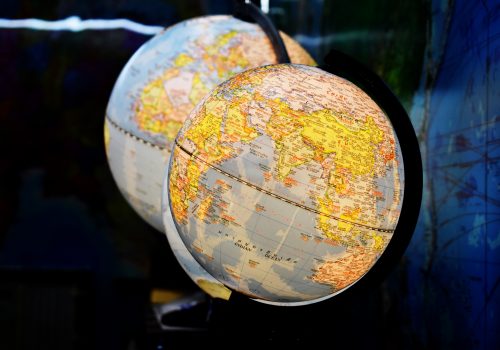Unpacking the geopolitics of technology
How second- and third-order implications of emerging tech are changing the world
Developing new technologies used to be primarily an economic and commercial issue, but it is increasingly also about foreign and security policy. Emerging technologies in particular have become both an object and a driver of international cooperation and competition, shaping the global landscape in different and sometimes unexpected ways. To put it simple, high tech has come to signify high politics, too. Today, digital and tech advancements are geopolitical issues of the highest order, even more so with the second wave of digital innovations, which are more systemic in reach and will determine future economic and technological supremacy as well as respective security environments.
The development of cutting-edge artificial intelligence (AI) capabilities, for instance, has become the new playing field for great power competition between the United States and China, both striving for digital supremacy and spheres of economic influence. Such increasing bipolarity in the international system comes with a price tag for many countries around the globe. European states in particular are torn between their alignment in terms of values with the United States and their dependency on close economic ties with China for the sake of their own economic health. In worrying about an escalating rivalry, many countries and state conglomerates have started to pursue their own digital sovereignty, yet lag behind in the global race of tech development, innovation, and cyber capabilities.
On technology-induced societal changes
The international debate concerning technological change also includes many ethical, social, and legal questions in fields such as human rights and individual freedoms, competition and market structure, consumer protection, or public health. Furthermore, the COVID-19 pandemic has raised significant questions about the role of technology in crisis management. Conversations around technological advances, new forms of work, and the change in skills needed have dominated the employment policy debate in many countries around the world. The platform economy, technological advances, and artificial intelligence are irrevocably changing economic structures, tasks, and ways of working, and even what we understand by “work.”
Europe, for example, is already a patchwork of highly varied local economies and markets. McKinsey Global Institute claims that by 2030, more than half of Europe’s workforce will face significant transitions. Automation will most likely require almost all workers to gain new skills. About ninety-four million employees may not need to change occupations altogether, but will need retraining, as technology already handles 20 percent of their current activities. While some workers in declining occupations might be able to find similar types of work, estimates indicate that some 21 million will need to change occupations by the end of this decade. Newly created jobs are going to require more sophisticated skills, which are already scarce today, and the potential social implications cannot be underestimated in scale.
Similar trends are becoming obvious in the United States, too. Having studied 702 occupational groupings, Oxford University researchers Carl Frey and Michael Osborne asserted already in 2013 that technology will inevitably transform many sectors of life: there is high probability, they estimated, that 47 percent of US workers will see their jobs automated within two decades. These fears have subsequently been echoed by similar studies inter alia from the European think tank Bruegel, the McKinsey Global Institute, and the Organisation for Economic Co-operation and Development (OECD), showing automation affecting between 14 and 54 percent of jobs in the “near future.” Furthermore, half (48%) of the 1,896 experts surveyed by the Pew Research Center in 2014 envisioned a future „in which robots and digital agents have displaced significant numbers of both blue- and white-collar workers—with many expressing concern that this will lead to vast increases in income inequality, masses of people who are effectively unemployable, and breakdowns in the social order.“ The future is already here, and these effects and trends, in addition to the geopolitical competition over new technologies, will continue to transform our world significantly.
In this paper, authors from the Atlantic Council and the Ministry for Foreign Affairs of Finland examine the transformation of technology and work in a broader social and political context, look at strategies that different regions of the world employ, and evaluate the transition’s geopolitical impact. The change in the global division of labor as well as its impacts are already well known. Consequences of the transformation of work challenge the very basis of the well-being of society, which has traditionally relied on productivity growth to increase wealth and living standards across the board. By all means, the fourth industrial revolution challenges the traditional segmentation describing work, skills, income, and many of the operating principles of society as it is known today. However, even if technology is reshaping the modern workplace and working processes, and jobs are lost sometimes faster than new work can be created, these changes do not happen overnight and decision makers have time to react to them.
This page contains only excerpts of the paper in order to give readers an introduction to the topic and the opportunity to browse through alternative futures. To access all content, please download a digital copy of the report.
Imagining alternative futures
To better understand the geopolitics of technology during the next five to ten years, the authors present three scenarios describing possible future developments. The projections portray a “not-so-distant-future,” in which technological transformation shapes a post pandemic world.
The first scenario, Postpandemic Letdown and Western Disarray (The Local Picture), uncovers the digital divides and inequalities within automated working life and COVID-19 aftershocks. The second scenario, Europe in a Bipolar Tech World (The Global Picture), reflects deepening US-China tensions and a drifting toward a transatlantic split. The third scenario, Counting the Costs of Technonationalism and the Balkanization of Cyberspace (The Regional Picture), depicts regulation and global governance efforts gone wrong. Together they broaden the horizon and underscore the importance of good decision-making today.



